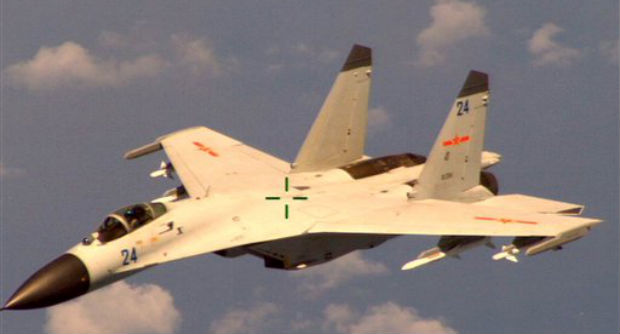
This handout photo provided by the Office of the Defense Secretary, taken Aug. 19, 2014, shows a Chinese fighter jet. A study has revealed that China has increased its military spending by almost 10 percent in 2014. AP Photo/OSD
STOCKHOLM, Sweden – Military spending increased sharply in 2014 in China and Russia and the Ukraine conflict prompted eastern European countries to boost their defense programs, according to a study by the Stockholm International Peace Research Institute (SIPRI) released Monday.
The United States remains the world’s biggest spender on defense, but it spent 6.4 percent less year-on-year in 2014, while China, Russia and Saudi Arabia — the world’s next three highest spenders — all increased their expenditures.
China’s spending last year was estimated at $216 billion, a 9.7 percent rise.
READ: Palace alarmed by China’s massive reclamation activities
https://globalnation.inquirer.net/120341/palace-alarmed-by-chinas-massive-reclamation-activities/
The conflict in Ukraine pitting Kiev against pro-Moscow rebels has seen eastern European countries near Russia rack up their spending and revise their defense plans.
“The Ukraine crisis has fundamentally altered the security situation in Europe, but so far the impact on military spending is mostly apparent in countries bordering Russia,” SIPRI’s Sam Perlo-Freeman said.
Ukraine’s budget jumped by over 20 percent to $4 billion, while Russia’s rose by more than eight percent to $84.5 billion.
The Russian government’s budget foresees an even bigger rise – of 15 percent – in 2015, but that could be cut due to the economic troubles linked to the Ukraine conflict.
READ: Russia warns of nuclear attack over US missile defense system
https://newsinfo.inquirer.net/680664/russia-warns-of-nuclear-attack-over-us-missile-defense-system
In Western Europe, as in the United States, budgets were shrinking, the report said.
While Washington is still the world’s top military spender, levels have shrunk by a fifth since they peaked in 2010, said SIPRI, an independent institute that studies conflict, weapons, arms control and disarmament.
“However, current US military spending is still 45 percent higher than in 2001, just before the 11 September terrorist attacks,” it added.
The United States boosted its military budget in the aftermath of suicide attacks on September 11, 2001 that killed nearly 3,000 people.
Within two years, it had launched two long and bloody wars in Afghanistan and Iraq.
Saudi Arabia top spender
Saudi Arabia’s 17 percent rise made it “the largest increase of any of the top 15 spenders worldwide”, SIPRI said.
The oil-rich state is a regional powerhouse with a significant role in several conflicts in the fraught region.
Since March 26, a Riyadh-headed coalition has carried out air strikes against Huthi Shiite rebels who overran Sanaa in September last year.
In Africa too, military spending has risen by nearly six percent, led by oil producers Algeria and Angola, said SIPRI.
Regional defense boost
“While total world military spending is mostly unchanged, some regions, such as the Middle East and much of Africa, are continuing to see rapid build-ups that are placing an increasingly high burden on many economies,” the institute’s Perlo-Freeman said.
“These increases partly reflect worsening security situations, but in many cases they are also the product of corruption, vested interests and autocratic governance.”
Global military spending totaled $1.8 trillion in 2014 — a fall of just 0.4 percent since 2013, the think tank said.